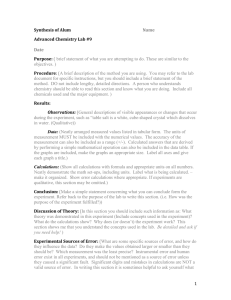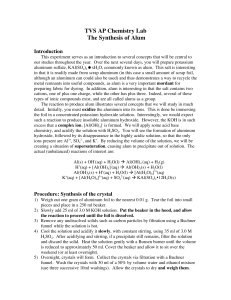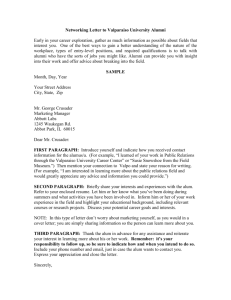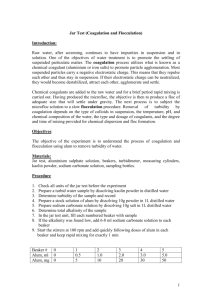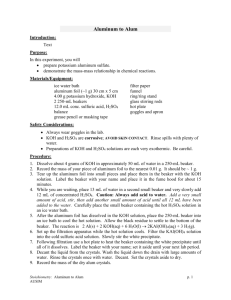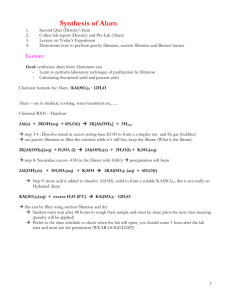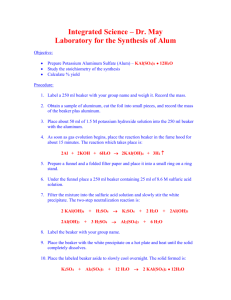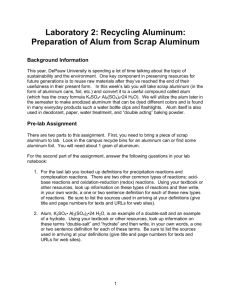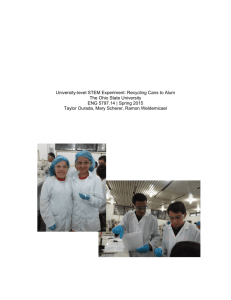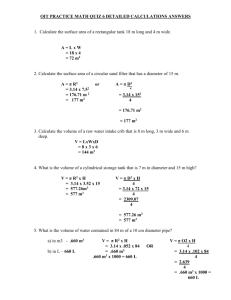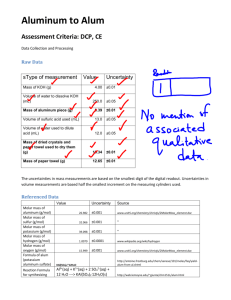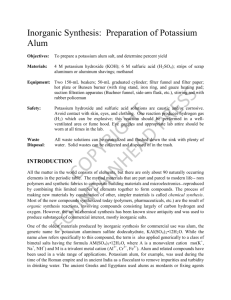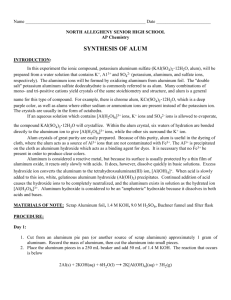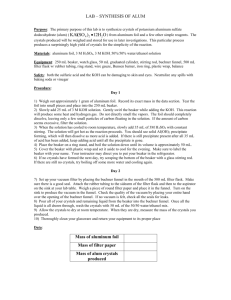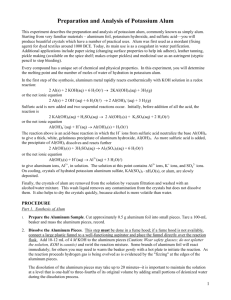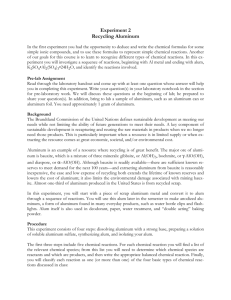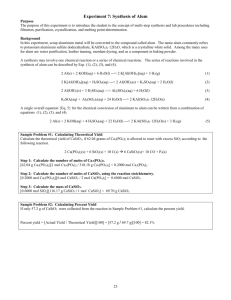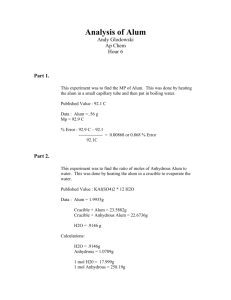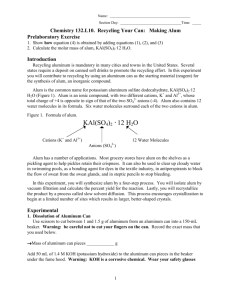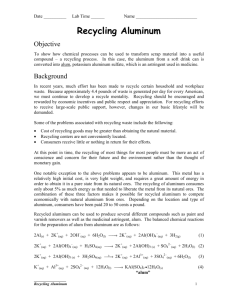Lab-Synthesis and Analysis of Alum
advertisement
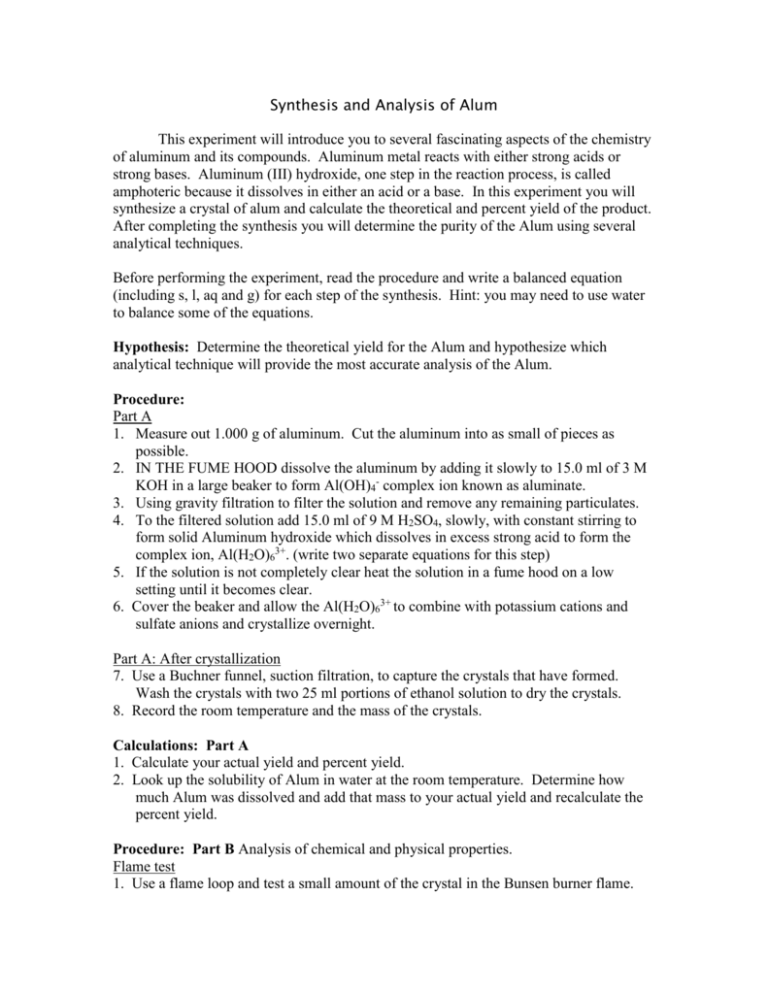
Synthesis and Analysis of Alum This experiment will introduce you to several fascinating aspects of the chemistry of aluminum and its compounds. Aluminum metal reacts with either strong acids or strong bases. Aluminum (III) hydroxide, one step in the reaction process, is called amphoteric because it dissolves in either an acid or a base. In this experiment you will synthesize a crystal of alum and calculate the theoretical and percent yield of the product. After completing the synthesis you will determine the purity of the Alum using several analytical techniques. Before performing the experiment, read the procedure and write a balanced equation (including s, l, aq and g) for each step of the synthesis. Hint: you may need to use water to balance some of the equations. Hypothesis: Determine the theoretical yield for the Alum and hypothesize which analytical technique will provide the most accurate analysis of the Alum. Procedure: Part A 1. Measure out 1.000 g of aluminum. Cut the aluminum into as small of pieces as possible. 2. IN THE FUME HOOD dissolve the aluminum by adding it slowly to 15.0 ml of 3 M KOH in a large beaker to form Al(OH)4- complex ion known as aluminate. 3. Using gravity filtration to filter the solution and remove any remaining particulates. 4. To the filtered solution add 15.0 ml of 9 M H2SO4, slowly, with constant stirring to form solid Aluminum hydroxide which dissolves in excess strong acid to form the complex ion, Al(H2O)63+. (write two separate equations for this step) 5. If the solution is not completely clear heat the solution in a fume hood on a low setting until it becomes clear. 6. Cover the beaker and allow the Al(H2O)63+ to combine with potassium cations and sulfate anions and crystallize overnight. Part A: After crystallization 7. Use a Buchner funnel, suction filtration, to capture the crystals that have formed. Wash the crystals with two 25 ml portions of ethanol solution to dry the crystals. 8. Record the room temperature and the mass of the crystals. Calculations: Part A 1. Calculate your actual yield and percent yield. 2. Look up the solubility of Alum in water at the room temperature. Determine how much Alum was dissolved and add that mass to your actual yield and recalculate the percent yield. Procedure: Part B Analysis of chemical and physical properties. Flame test 1. Use a flame loop and test a small amount of the crystal in the Bunsen burner flame. 2. Record the resultant color. Gravimetric analysis for SO42- anion 1. Mass lg of the sample and dissolve in 50 ml of water. 2. Write a balanced equation for the reaction of the Alum and strontium nitrate. Calculate the volume of strontium nitrate needed to react completely with the Alum. Double the calculated volume and add it to the Alum. 3. Heat the solution, but do not boil, for fifteen minutes. 4. Filter the solution using a pre-weighed filter paper. 5. Dry the precipitate overnight. 6. Record the mass of the precipitate. Percentage of water in a Hydrate 1. Mass 1 g of the sample. 2. Transfer the sample to a pre-weighed dry, crucible. 3. Heat the crucible with the lid askew for 10 minutes. 4. Allow to cool for 2 minutes and mass. 5. Reheat the crucible with its lid askew for 5 more minutes, cool for 2 minutes and mass. If the mass has not changed by more the .02 then record the final mass. If it changes reheat and cool until the mass is constant. Physical Properties 1. Record the color, shape and odor of the Alum. 2. Melt the Alum in a small beaker on a hot plate until it is all dissolved. Record the temperature of the sample as it cools and recrystallizes. Calculations: Part B 1. Calculate the mass percent of SO42- and water in the Alum from your data. 2. Calculate the theoretical mass percent using a published formula of alum.

